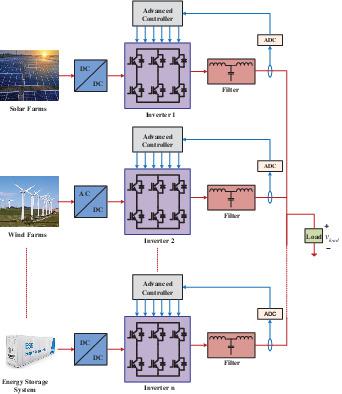当前位置:
X-MOL 学术
›
Int. Trans. Electr. Energy Syst.
›
论文详情
Our official English website, www.x-mol.net, welcomes your
feedback! (Note: you will need to create a separate account there.)
Implementation and comparison of droop control, virtual synchronous machine, and virtual oscillator control for parallel inverters in standalone microgrid
International Transactions on Electrical Energy Systems ( IF 1.9 ) Pub Date : 2021-03-11 , DOI: 10.1002/2050-7038.12859 Vikash Gurugubelli 1 , Arnab Ghosh 1 , Anup Kumar Panda 1 , Shubhobrata Rudra 1
International Transactions on Electrical Energy Systems ( IF 1.9 ) Pub Date : 2021-03-11 , DOI: 10.1002/2050-7038.12859 Vikash Gurugubelli 1 , Arnab Ghosh 1 , Anup Kumar Panda 1 , Shubhobrata Rudra 1
Affiliation

|
In recent times, renewable energy sources (RESs) have been potential alternatives over the conventional generation systems connected to the grid. The power electronic inverters are the principal media of interface for connecting the RESs to the utility grid system. This work is primarily focused on the comparative analysis of Droop, virtual synchronous machine (VSM), and virtual oscillator control (VOC) techniques for the parallel operated inverters in a standalone Microgrid (MG). Droop control emulates only the droop characteristics of synchronous machines such that the transient response of this controller is not significant. VSM imitates not only the droop characteristics of synchronous machines but also the swing equation. Therefore, VSM has a remarkable difference in the dynamic performance of the system. In droop and VSM, the feedback signals such as voltage and current are measured to calculate the averaged real and reactive powers. However, the VOC works on instantaneous feedback signals such that it achieves much faster synchronization and good power‐sharing. The philosophy of the proposed VOC is to control an inverter such that it emulates the behavior of a nonlinear dead‐zone oscillator. The performance analysis of the system with the aforementioned controllers has been studied based on MATLAB/Simulink and Opal‐RT digital simulation. From the comparative analysis, it is observed that the VOC gives a better performance compared to droop and VSM control. The experimental results show the efficacy of the proposed VOC control method.
中文翻译:

独立微电网中并行逆变器的下垂控制,虚拟同步机和虚拟振荡器控制的实现和比较
近年来,可再生能源(RES)已成为连接到电网的常规发电系统的潜在替代品。电力电子逆变器是用于将RES连接到公用电网系统的接口的主要介质。这项工作主要集中在对独立微电网(MG)中并联运行的逆变器的下垂,虚拟同步机(VSM)和虚拟振荡器控制(VOC)技术进行比较分析。下垂控制仅模拟同步电机的下垂特性,因此该控制器的瞬态响应不明显。VSM不仅模拟同步电机的下垂特性,而且还模拟摆动方程。因此,VSM在系统的动态性能方面具有显着差异。在下垂和VSM中,测量电压和电流等反馈信号,以计算平均有功功率和无功功率。但是,VOC可以处理瞬时反馈信号,从而可以实现更快的同步和良好的功率共享。提出的VOC的原理是控制逆变器,使其模仿非线性死区振荡器的行为。基于MATLAB / Simulink和Opal-RT数字仿真,研究了具有上述控制器的系统的性能分析。从比较分析中可以看出,与下垂和VSM控制相比,VOC的性能更好。实验结果表明了所提出的VOC控制方法的有效性。VOC可处理瞬时反馈信号,从而实现更快的同步和良好的功率共享。提出的VOC的原理是控制逆变器,使其模仿非线性死区振荡器的行为。基于MATLAB / Simulink和Opal-RT数字仿真,研究了具有上述控制器的系统的性能分析。从比较分析中可以看出,与下垂和VSM控制相比,VOC的性能更好。实验结果表明了所提出的VOC控制方法的有效性。VOC可处理瞬时反馈信号,从而实现更快的同步和良好的功率共享。提出的VOC的原理是控制逆变器,使其模仿非线性死区振荡器的行为。基于MATLAB / Simulink和Opal-RT数字仿真,研究了具有上述控制器的系统的性能分析。从比较分析中可以看出,与下垂和VSM控制相比,VOC的性能更好。实验结果表明了所提出的VOC控制方法的有效性。基于MATLAB / Simulink和Opal-RT数字仿真,研究了具有上述控制器的系统的性能分析。从比较分析中可以看出,与下垂和VSM控制相比,VOC的性能更好。实验结果表明了所提出的VOC控制方法的有效性。基于MATLAB / Simulink和Opal-RT数字仿真,研究了具有上述控制器的系统的性能分析。从比较分析中可以看出,与下垂和VSM控制相比,VOC的性能更好。实验结果表明了所提出的VOC控制方法的有效性。
更新日期:2021-05-03
中文翻译:

独立微电网中并行逆变器的下垂控制,虚拟同步机和虚拟振荡器控制的实现和比较
近年来,可再生能源(RES)已成为连接到电网的常规发电系统的潜在替代品。电力电子逆变器是用于将RES连接到公用电网系统的接口的主要介质。这项工作主要集中在对独立微电网(MG)中并联运行的逆变器的下垂,虚拟同步机(VSM)和虚拟振荡器控制(VOC)技术进行比较分析。下垂控制仅模拟同步电机的下垂特性,因此该控制器的瞬态响应不明显。VSM不仅模拟同步电机的下垂特性,而且还模拟摆动方程。因此,VSM在系统的动态性能方面具有显着差异。在下垂和VSM中,测量电压和电流等反馈信号,以计算平均有功功率和无功功率。但是,VOC可以处理瞬时反馈信号,从而可以实现更快的同步和良好的功率共享。提出的VOC的原理是控制逆变器,使其模仿非线性死区振荡器的行为。基于MATLAB / Simulink和Opal-RT数字仿真,研究了具有上述控制器的系统的性能分析。从比较分析中可以看出,与下垂和VSM控制相比,VOC的性能更好。实验结果表明了所提出的VOC控制方法的有效性。VOC可处理瞬时反馈信号,从而实现更快的同步和良好的功率共享。提出的VOC的原理是控制逆变器,使其模仿非线性死区振荡器的行为。基于MATLAB / Simulink和Opal-RT数字仿真,研究了具有上述控制器的系统的性能分析。从比较分析中可以看出,与下垂和VSM控制相比,VOC的性能更好。实验结果表明了所提出的VOC控制方法的有效性。VOC可处理瞬时反馈信号,从而实现更快的同步和良好的功率共享。提出的VOC的原理是控制逆变器,使其模仿非线性死区振荡器的行为。基于MATLAB / Simulink和Opal-RT数字仿真,研究了具有上述控制器的系统的性能分析。从比较分析中可以看出,与下垂和VSM控制相比,VOC的性能更好。实验结果表明了所提出的VOC控制方法的有效性。基于MATLAB / Simulink和Opal-RT数字仿真,研究了具有上述控制器的系统的性能分析。从比较分析中可以看出,与下垂和VSM控制相比,VOC的性能更好。实验结果表明了所提出的VOC控制方法的有效性。基于MATLAB / Simulink和Opal-RT数字仿真,研究了具有上述控制器的系统的性能分析。从比较分析中可以看出,与下垂和VSM控制相比,VOC的性能更好。实验结果表明了所提出的VOC控制方法的有效性。











































 京公网安备 11010802027423号
京公网安备 11010802027423号